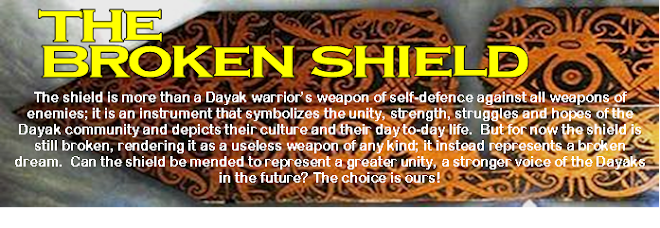
This book is written based on my experience – from what I read, I did, I wrote, I saw and what I heard as well as from my discussions with civil servants, reporters, friends and politicians. This is my memoir, my record."
I was among the lucky ones to have witnessed and recorded so many historical and political events that occurred between the times of Sarawak gaining its independence from the British in late 1963 to the present day Sarawak in the Federation of Malaysia - a period of more than 40 years. As Assistant Press Officer with the Information Department between 1965 and 1975, my duties had not only endeared me to people of all walks of life, but had also taken me to almost every corner of Sarawak.
Being an Iban, I was assigned to cover the visits of VIPs to remote areas of Sarawak where other reporters could not go. I became both a reporter and a photographer. And my stories and photographs became the official versions of government press releases and statements. Among those whom I covered were Tunku Abdul Rahman, Tun Abdul Razak, Tun Dr. Ismail, Tan Sri Ghazali Shafie, Tan Sri Sardon, Tan Sri Musa Hitam, Datuk Stephen Kalong Ningkan, Datuk Penghulu Tawi Sli, Datuk Abdul Rahman Yakub, Datuk Abdul Taib Mahmud, Tan Sri Temenggong Jugah, Simon Dembab Maja, Leonard Linggi Jugah and Dunstan Endawie.
It was during such visits that I had seen and witnessed numerous events such as demonstrations, general elections, political crises, rallies and meetings and launching of various development programmes. For example, I had seen the downfall of Ningkan Government, the swearing-in of Tawi Sli as Chief Minister as well as the premature swearing in of Rahman as Chief Minister, the merger of Parti Bumiputera and Parti Pesaka, Sarawak National Party (SNAP) crisis (1981-1983), the formation of Parti Bansa Dayak Sarawak (PBDS), the Ming Court affairs, deregistrations of SNAP and PBDS, the registrations of Sarawak Progressive Democratic Party (SPDP) and Parti Rakyat Sarawak (PRS) as well as being involved in the formation of the proposed Malaysian Dayak Congress (MDC).
Towards the end of 1975, I left the Information Department for the Police Department as the Press Liaison Officer. My duties in the department were similar to those in the Information Department. The only difference was that my efforts were concentrated on Police activities. Here again I had the privilege of accompanying Commissioners of Police during those visits to other divisions, where we were briefed on security, crime and political situations in the State. Giving those briefings were senior Criminal Investigation and Special Branch officers. Some of my political knowledge came from these briefings by the Special Branch officers. I served nine Commissioners of Police during my 22 years and 10 months in the Police.
As a retired civil servant, I look back to the time when I joined the government with a feeling of nostalgia, especially when reading some of the files and paper cuttings on politics that I had collected since 1965. I wrote many of these political articles for The Sarawak Tribune, The Borneo Post, The Borneo Bulletin, The Sun, The Borneo Sun and The Malaysian Today. I had to use nom-de-plumes, because as a civil servant I was not allowed to contribute political articles to the newspapers. My job was only to write government press releases. The extra money I earned through writings helped me to send my four children to universities.
It was during this reminiscence that I decided to write a book. Some of the articles that I wrote decades ago are being included in the book I now call “The Broken Shield”. This book attempts to cover political events from my perspective and knowledge.
This book is about a journey or a “road map” of Dayak political unity from the day Sarawak gained independence until this present day political scenario. Along the journey, the Dayak unity was persistently being undermined. Their hopes and struggles were constantly being frustrated either by the Dayaks on their own out of personal greed and jealousy or they worked in collaboration with others, whose interests were detrimental to the Dayaks’ political struggles.
You may ask why “The Broken Shield”? The shield is more than a Dayak warrior’s weapon of self-defence against all weapons of enemies; it is an instrument that symbolizes the unity, strength, struggles and hopes of the Dayak community and depicts their culture and their day-to-day life. And for this reason, the shield has been incorporated in the logos or symbols of all Dayak-based parties like SNAP, SPDP, PBDS and PRS. Even PESAKA, which merged with Bumiputera to form Pesaka Bumiputera Bersatu (PBB), to this day continues to retain the shield as its emblem to reflect its aim of protecting Dayaks’ interests in PBB.
Figuratively speaking, the shield breaks into pieces in its efforts to protect the Dayaks’ unity, interests and rights, and its bits and pieces have been scattered all over the place and along the road of the Dayaks’ political journey to an unknown destination. Translated into modern day politics, “The Broken Shield” reflects the Dayaks’ profound disunity while its fragments figuratively represent each and every one of the Dayaks who are divided and scattered among the existing political parties in the State, namely PBB, SUPP, SNAP, SPDP, PRS, STAR and in the proposed Malaysian Dayak Congress (MDC).
My intention of writing this book is to let the future generations know, study and perhaps learn from the failures, misgivings and misfortunes of their forefathers. And although for now it is impossible to unite the Dayaks under one political umbrella, it is hoped that the future generations may be more successful in forging unity among the Dayaks. The possibility of the broken shield being pieced together again is not impossible. God willing, with political will and sacrifice, I may even live to see it happens.
Joseph Tawie
Kuching, Sarawak
September 2007


